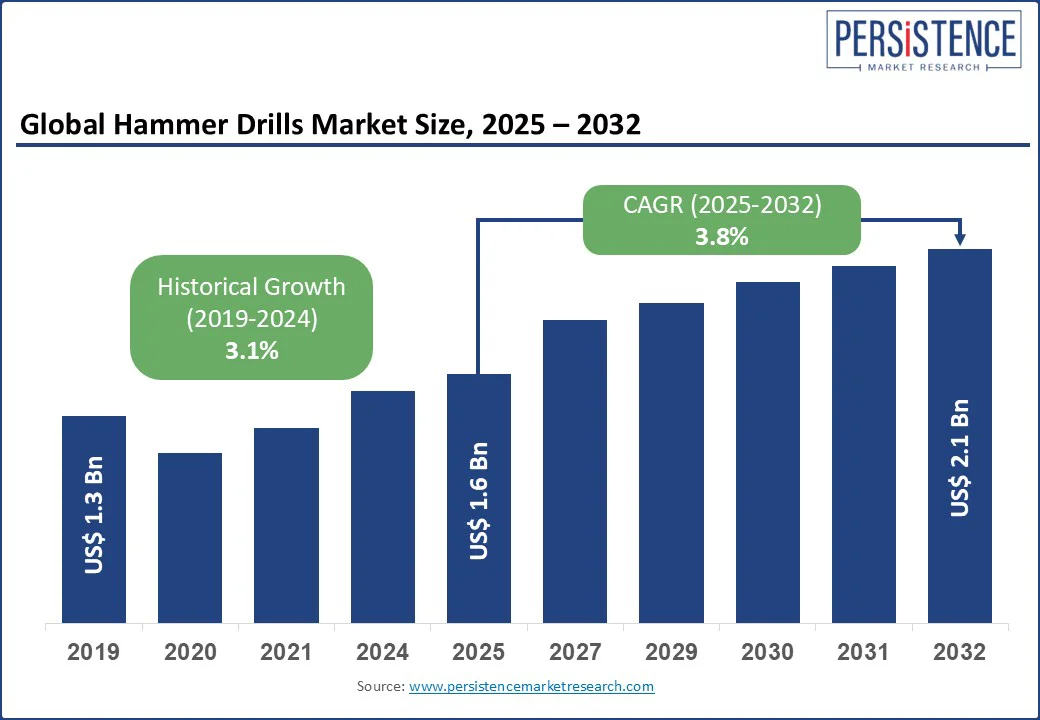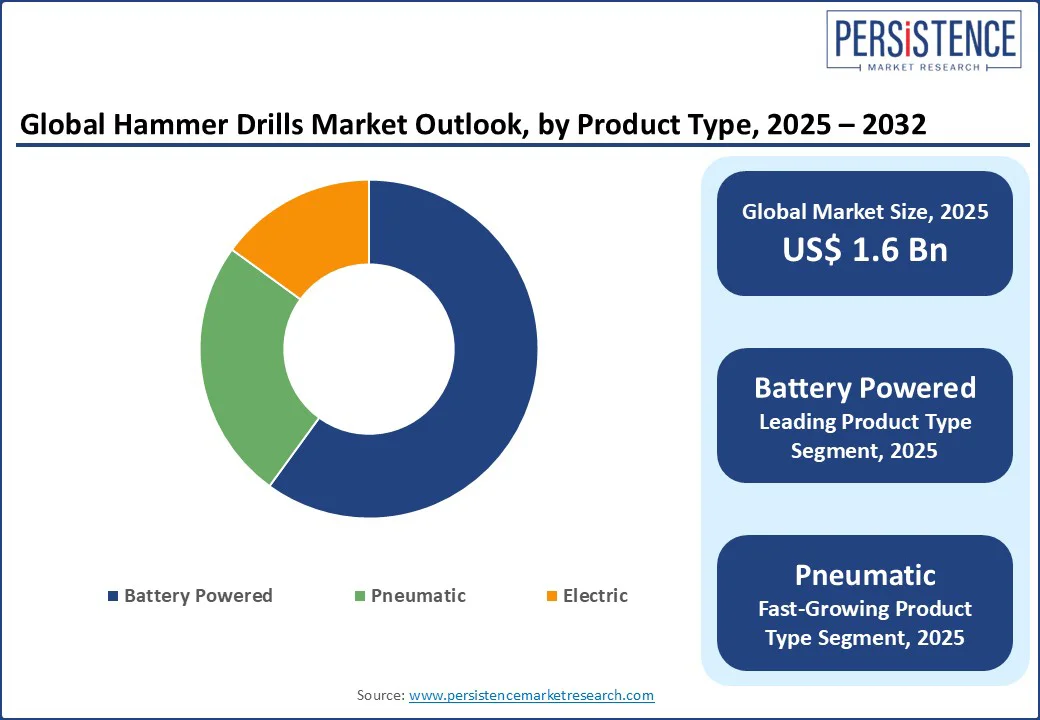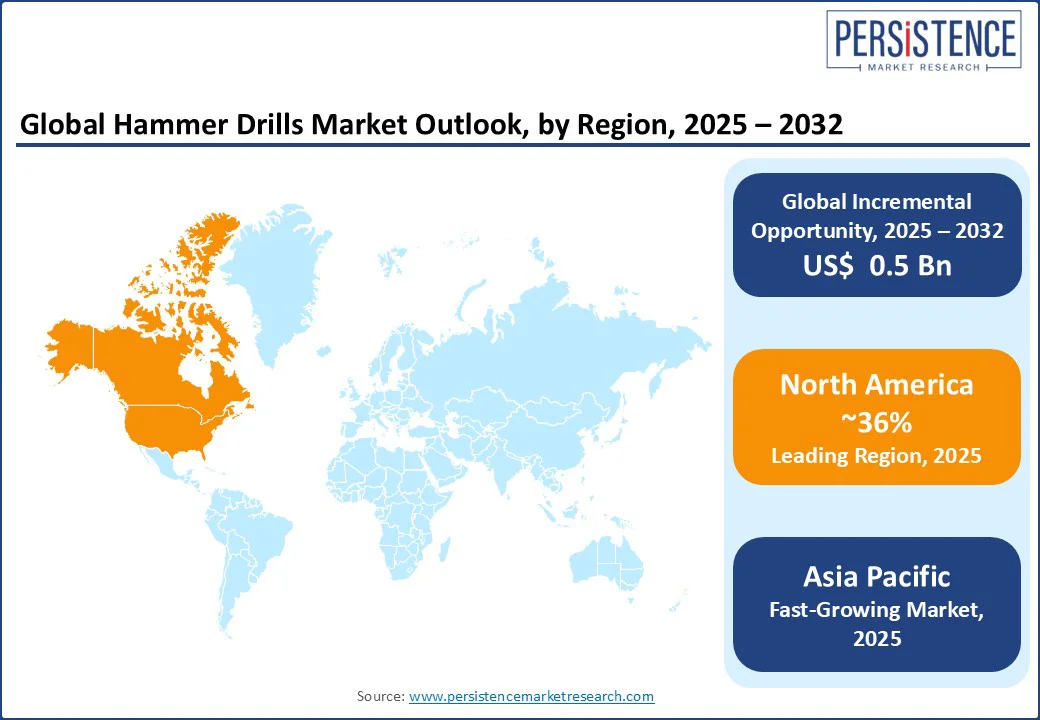ID: PMRREP32372| 192 Pages | 18 Aug 2025 | Format: PDF, Excel, PPT* | Industrial Automation

The global Hammer Drills Market size is likely to grow at US$ 1.6 Bn in 2025 and is expected to reach US$ 2.1 Bn by 2032, registering a CAGR of 3.8% during the forecast period from 2025 to 2032.
The hammer drill industry has witnessed a steady growth, fueled by increasing demand for versatile and efficient drilling tools across construction, infrastructure, and home improvement sectors. The market is driven by rapid urbanization, infrastructure development, and the growing popularity of cordless, battery-powered tools for professional and DIY applications.
The sector benefits from technological advancements, such as improved battery life and lightweight designs, which enhance user convenience and efficiency. In addition, the shift toward sustainable and energy-efficient tools aligns with global environmental goals, further boosting market growth.

Key Industry Highlights:
|
Global Market Attribute |
Key Insights |
|
Hammer Drills Market Size (2025E) |
US$ 1.6 Bn |
|
Market Value Forecast (2032F) |
US$ 2.1 Bn |
|
Projected Growth (CAGR 2025 to 2032) |
3.8% |
|
Historical Market Growth (CAGR 2019 to 2024) |
3.1% |
The growth in construction and infrastructure development is a key driver propelling the hammer drill market. Rapid urbanization and expanding populations worldwide have intensified the need for new residential, commercial, and industrial structures, boosting demand for efficient construction tools.
Governments across various regions are investing heavily in infrastructure projects, including highways, bridges, airports, and public transit systems, to support economic growth and enhance connectivity. These large-scale projects require durable and high-performance equipment, making hammer drills indispensable for tasks such as drilling into concrete, masonry, and other hard materials. Additionally, renovation and remodeling activities in aging urban centers further contribute to steady market demand.
Technological advancements in hammer drills, including cordless models with improved battery life and ergonomic designs, enhance productivity and appeal to both professionals and DIY enthusiasts. For instance, the U.S. Infrastructure Investment and Jobs Act, with its multi-billion-dollar allocation toward rebuilding roads and bridges, has significantly increased demand for construction tools such as hammer drills. Overall, the surge in construction and infrastructure projects globally is driving hammer drill sales and fostering innovation in tool design and functionality.
High initial costs of advanced hammer drills pose a significant restraint on market growth. Modern hammer drills, especially cordless models equipped with brushless motors, lithium-ion batteries, and smart features, offer enhanced performance, durability, and user convenience. However, these technological advancements come with a higher price tag compared to traditional corded or basic models.
This upfront investment can deter individual consumers, small contractors, and budget-conscious buyers from adopting advanced tools despite their long-term benefits. In emerging markets where cost sensitivity is high, the premium pricing limits market penetration and slows adoption rates.
For instance, the price of a high-end cordless hammer drill from brands such as DEWALT or Bosch can exceed $400, compared to less than $100 for basic corded models, making it less accessible for small-scale users.
The need for compatible batteries and chargers further adds to the overall cost. Consequently, the high initial expenditure acts as a barrier, restricting broader usage and impeding faster growth of the advanced hammer drill segment globally.
Advancements in battery technology present a significant opportunity for the power tools market, especially in the cordless hammer drill segment. Improved battery performance, including higher energy density, faster charging times, and longer lifespan, is enhancing the overall user experience by providing extended operational time and reduced downtime.
For instance, DEWALT’s FlexVolt batteries offer compatibility across multiple tools with up to 60% more runtime, enabling professionals to work longer without interruptions. Lithium-ion batteries, now widely adopted, are lighter and more efficient compared to older nickel-cadmium types, making cordless tools more portable and easier to handle. Companies such as Bosch are investing in solid-state battery research, which promises greater safety and durability. These innovations are driving the adoption of cordless tools among both professionals and DIY enthusiasts. As battery costs decrease and energy efficiency improves, cordless hammer drills are becoming more affordable and accessible, expanding the domain and fostering further product innovation.
Battery hammer Drills dominate the industry, expected to account for approximately 60% of the industry share in 2025. Their dominance stems from their portability, versatility, and suitability for both professional and residential applications. Battery-powered drills, equipped with advanced lithium-ion batteries, offer cordless convenience without sacrificing power, making them ideal for construction sites and home improvement projects. Their compatibility with various drill bits and attachments enhances their applicability across industries such as construction, metalworking, and decoration.
The Pneumatic Hammer Drills segment is the fastest-growing from 2025 to 2032, driven by increasing demand for heavy-duty tools in infrastructure and industrial applications. Pneumatic drills, powered by compressed air, offer superior power and durability for drilling through tough materials such as concrete and steel, making them ideal for large-scale projects. Advancements in pneumatic technology, such as improved air efficiency and reduced vibration, are accelerating their adoption, particularly in emerging markets with expanding infrastructure projects.
Professional Services lead the hammer drills market, holding a 38% share in 2025. This segment’s dominance is driven by the widespread use of hammer drills in construction, infrastructure, and industrial projects, where their ability to handle tough materials such as concrete and masonry is critical. Major construction firms rely on hammer drills for tasks such as installing anchors, drilling foundations, and retrofitting buildings, with demand further boosted by global infrastructure investments.
The Household segment is the fastest-growing, fueled by the rising popularity of DIY home improvement projects. The availability of user-friendly, battery-powered hammer drills has made them accessible to homeowners for tasks such as installing shelves, assembling furniture, and small renovations. The growth of online tutorials and home improvement content on platforms such as YouTube has further encouraged DIY enthusiasts, particularly in North America and Europe, to adopt hammer drills for personal use.
Residential & Commercial Buildings Construction dominates the hammer drills market, holding a 50% share in 2025. The segment’s leadership is driven by the global surge in construction activities, including residential housing, commercial complexes, and urban redevelopment projects. Hammer drills are essential for tasks such as drilling foundations, installing fixtures, and retrofitting structures, making them indispensable in this sector.
The infrastructure segment is the fastest-growing, driven by increasing government investments in public infrastructure, such as roads, bridges, and airports. For instance, India’s National Infrastructure Pipeline is boosting demand for heavy-duty hammer drills. Regulatory requirements for high-performance, durable tools in infrastructure projects further accelerate the adoption of advanced hammer drills in this segment.

North America is projected to hold approximately 36% of the global hammer drills market share in 2025, driven by several key factors. Rapid urbanization across the region fuels continuous demand for residential, commercial, and infrastructure construction projects, which are major end-users of hammer drills. Robust construction activities, supported by government investments in infrastructure development, contribute significantly to market growth.
The growing industrial output in North America stimulates demand for durable and efficient power tools, including hammer drills, to support manufacturing and maintenance operations. Technological advancements, such as the adoption of cordless hammer drills with improved battery life and brushless motors, further boost market penetration by enhancing user convenience and performance. Moreover, rising DIY culture and home renovation trends among consumers create additional demand. While China and India drive industrial growth globally, North America’s strong construction and industrial sectors position it as a key market for hammer drills worldwide.
Europe holds a significant share in the global hammer drills market, driven by strong construction activities, advanced manufacturing, and growing adoption of cordless tools. Leading countries include Germany, the UK, and France. Germany benefits from its advanced industrial base and leadership in sustainable tool manufacturing, with companies such as Bosch and Hilti investing in ergonomic and energy-efficient hammer drills.
The UK’s market is bolstered by the growth of residential construction and DIY trends, supported by retailers such as B&Q. France’s market is driven by infrastructure projects and investments in sustainable tools, aligning with the EU’s Green Deal objectives. The EU’s stringent regulations, such as the Ecodesign Directive, promote the adoption of energy-efficient tools, though compliance with complex environmental standards poses challenges. Europe’s hammer drill market is projected to grow steadily from 2025 to 2032.
The Asia Pacific hammer drills market is experiencing rapid growth, driven primarily by robust construction activities and substantial infrastructure investments across the region. Countries such as China, India, Japan, and Southeast Asian nations are witnessing significant urbanization and industrialization, fueling demand for power tools, including hammer drills.
The expansion of residential and commercial building projects, along with government initiatives to develop transportation and energy infrastructure, are key growth drivers. The rising DIY culture and increasing consumer interest in home improvement projects contribute to market expansion, especially among the growing middle-class population.
Technological advancements such as cordless hammer drills with enhanced battery life and brushless motors are further propelling market adoption. While the U.S. and Canada are not part of the Asia Pacific, the mention of growing DIY trends there highlights a global pattern of increased consumer engagement in power tool usage. Overall, the Asia Pacific region is poised for sustained hammer drill market growth due to favorable economic and demographic trends.

The Global hammer drills market is highly competitive, characterized by a mix of global and regional players. In developed regions such as North America and Europe, large firms such as Bosch Power Tools, DEWALT, and Hilti dominate through innovation, brand reputation, and partnerships with construction and retail giants. In the Asia Pacific, rapid construction growth and increasing DIY adoption are attracting investments from both local and international players. Companies are focusing on product innovation, sustainability, and ergonomic designs to gain a competitive edge. Advancements in battery technology and digital marketing strategies, such as targeted campaigns on e-commerce platforms, are key differentiators. Strategic acquisitions and R&D investments are further intensifying the competitive landscape.
The global hammer drills market is projected to reach US$ 1.6 Bn in 2025.
The surge in construction and infrastructure development is a key driver.
The Hammer Drills market is poised to witness a CAGR of 3.8% from 2025 to 2032.
Advancements in battery technology are a key opportunity.
Bosch Power Tools, Makita Corporation, DEWALT, Hilti Corporation, and Milwaukee Tool are key players.
|
Report Attribute |
Details |
|
Historical Data/Actuals |
2019 - 2024 |
|
Forecast Period |
2025 - 2032 |
|
Market Analysis Units |
Value: US$ Bn, Volume: As Applicable |
|
Geographical Coverage |
|
|
Segmental Coverage |
|
|
Competitive Analysis |
|
|
Report Highlights |
|
|
Customization and Pricing |
Available upon request |
By Product Type
By Application
By End-use
By Region
Delivery Timelines
For more information on this report and its delivery timelines please get in touch with our sales team.
About Author